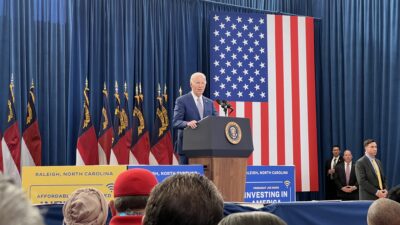In fall 2022, EdNC visited all 58 community colleges as part of our Impact58 blitz, studying the economic impact of our community colleges.
Community college leaders spoke about many factors that contribute to a financially healthy community college. EdNC identified five indicators that contribute to how well colleges are able to serve their students and communities.
In fall 2023, EdNC analyzed systemwide data across the 58 community colleges on the indicators, which is included in the release today. We followed up with about a dozen community college leaders about how these indicators collectively contribute to more financially flexible, stable colleges.
The five indicators
- Special appropriations in the state budget for individual community colleges. Do colleges have good relationships with their legislative delegation? Does their legislative delegation have influence within the General Assembly? This matters for how colleges can access funds for things like new programs and equipment.
- County support. The county is responsible for financially supporting the “physical plant” of the college. Varying levels of county wealth, along with college-county relationships, influence how much county support colleges get for new construction and initiatives.
- The rate of dual enrollment. How are colleges leveraging dual enrollment, along with relationships with their K-12 school district(s)? Dual enrollment has contributed significant FTE for some colleges, particularly in rural counties with declining population trends.
- Foundations and philanthropic support. Are the college foundations successful at raising outside funding? The scale of innovative initiatives at colleges is largely influenced by access to philanthropic support through foundations and grants.
- Receipts from tuition and fees. All 58 community colleges take in student tuition and fees and those are by law deemed state funds. In 2023-24, 21.5% of the total state budget for community colleges is funded through expected receipts.
Taken together these indicators have influenced each community college’s ability to thrive, funding student scholarships and new innovative workforce programs. Successfully funding both is particularly important as the state works to meet its 2030 educational attainment goal and demand for skilled workers.
Without additional funding, community college leaders told EdNC, it’s difficult for colleges to respond effectively, or with the creativity and flexibility required.
“All of these resources, collectively, are essential in helping us do the work that we do,” said Halifax Community College President Dr. Patrena Elliott.
Here is a link to the study.
For more information, contact lead reporter Hannah McClellan.
EducationNC (EdNC) works to expand educational opportunities for all students in North Carolina, increase their academic attainment, and improve the performance of the state’s public schools. We have provided residents and policymakers with nonpartisan data, research, news, information, and analysis about the major trends, issues, and challenges bearing on education for nearly a decade. Our work encourages informed participation and strong leadership on behalf of the students of North Carolina.


